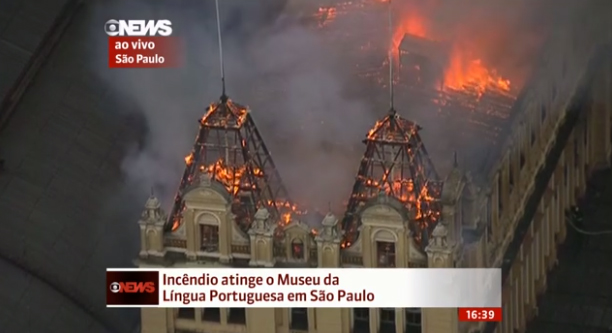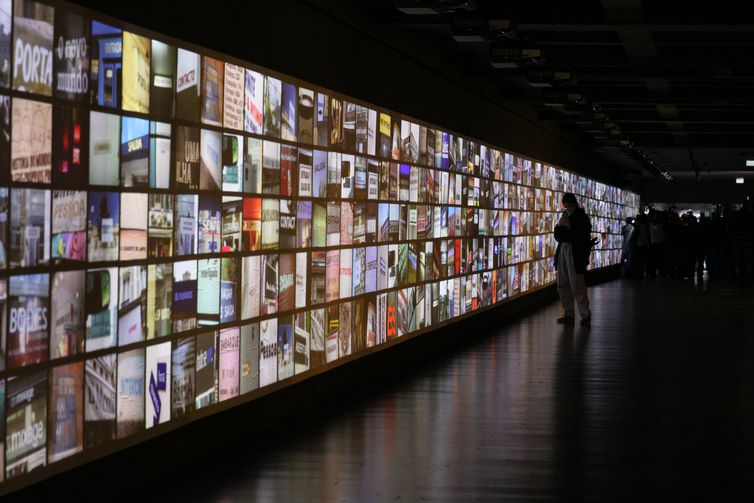
The Museum of the Portuguese Language (Museu da Língua Portuguesa), a space that offers visitors a journey through the diversity of the Portuguese language, was reopened to the public on the 31st of July. The museum at Estação da Luz, a late 19th century building in downtown São Paulo, was destroyed by a major fire on December 21, 2015 and was completely renovated.

The reopening ceremony was attended by Brazilian and international authorities, including the Presidents of Portugal, Marcelo Rebelo de Sousa, and Cape Verde, Jorge Carlos Fonseca, the Minister of Culture of Angola, Jomo Francisco Fortunato, the former Brazilian Presidents Fernando Henrique Cardoso and Michel Temer and the Mayor of São Paulo, Ricardo Nunes.
The heads of State of Portuguese-speaking countries praised the partnership between the government and the private sector to rebuild the space, considered one of the most important cultural heritages in the world. “Six years later we are here not to forget the ashes of the past, but based on them to build the future in this power of all eras called Brazil, in this metropolis of so many languages called São Paulo”, declared Marcelo Rebelo de Sousa, President of Portugal.
Cape Verde’s President, Jorge Carlos Fonseca, spoke about the importance of uniting Portuguese-speaking countries. “Language is created and recreated through contacts between different communities. May we be more than a community of states, a community of peoples who share common values such as fraternity, freedom and democracy, based on the fundamental pillar which is the Portuguese language, the language of all of us”, he said.

On the day it reopened its doors, the Museum debuted the most recent Portuguese honorific order, receiving from the hands of Marcelo Rebelo de Sousa, the new Camões medal. Created last June at the initiative of the Portuguese Parliament, the Camões medal is intended to “reward relevant services provided by national or foreign natural or legal persons to Portuguese culture, its projection in the world, the preservation of emigrants’ ties with the motherland, the promotion of the Portuguese language and the intensification of cultural relations between peoples and communities that speak Portuguese.” The decoration was awarded “in the name of the future” of the Portuguese language, for which “the youngest and more numerous” are “more essential”, said Marcelo Rebelo de Sousa in an allusion to the number of Brazilian speakers, which in São Paulo alone are over 12 million. “It is this future that, in the name of Portugal and of all Portuguese, I celebrate by awarding the Museum of the Portuguese Language with an honorary order just created”, said Marcelo Rebelo de Sousa, adding: “This museum will be the first of the first awarded. that is to say this São Paulo, this Brazil and this Portuguese language that unites us all over the world”.
At the official reopening ceremony, the Brazilian National Anthem and the Anthem of Portugal were sung by Fafá de Belém.
“We of the Portuguese Language”( “Nós da Língua Portuguesa”), an exhibition that visitors can now see at the Museum, brings a kind of kaleidoscope, a canvas that explores songs, poems and images based on research in places like Mozambique, Angola, Cape Verde, Portugal and Macau (China), with the advice of specialists and writers such as the Angolan José Eduardo Agualusa and the Mozambican Mia Couto. “This exhibition is about the global presence of Portuguese, spoken by 261 million people spread across all continents. Even using the same language, each of these places has its specificities, accents and culture”, said Isa Grinspum Ferraz, special curator of the Museum.

The museum opened to the public for the first time in 2006, having chosen as its home the city of São Paulo, which houses the largest population of Portuguese speakers in the world.
Between March 2006 and until the fire in December 2015, the museum received around 4 million visitors, with more than 30 temporary exhibitions in addition to courses, lectures, debates and artistic presentations. Among those honored with exhibitions, there are writers such as Clarice Lispector, Machado de Assis, Cora Coralina, Fernando Pessoa, Oswald de Andrade, Jorge Amado, Rubem Braga, Guimarães Rosa, Agustina Bessa-Luís and Gilberto Freyre.
The reconstruction of the Museum was established by the Government of São Paulo. The works began in 2017 and were divided into three phases: restoration of the interior and facades; reconstruction of the cover destroyed in the fire; and scale-up and improvement interventions.
The Government of São Paulo, together with the Roberto Marinho Foundation, received support from dozens of partners. The total investment was over R$85 million (about 14 million euros), including insurance indemnity and sponsorship of several companies, in addition to the State contribution and support from the Fundação Calouste Gulbenkian, from Camões – Instituto da Cooperação e da Língua, ID Brasil and the Federal Government.
During the reconstruction, the Museum continued in contact with the public through cultural and educational activities, such as the traveling exhibition “The Portuguese Language in Us” (“A Língua Portuguesa em Nós”), presented in 2018 in Cape Verde, Mozambique and Angola, in Africa; in Portugal and Brazil.




